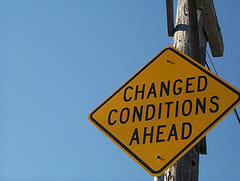I am going through the process of reconfiguring my website. Note that I did not say redesign. While there will be an incredible design element provided by the fine folks at Studio Press and Copyblogger Media, my real focus is on configuration around something I’m going to call “Ideal Visitor Optimized Goals.”
Before I explain what it is I think I mean by that, let me talk about the past.

Like many marketers over the last decade or so, a great deal of my web strategy has revolved around producing content that draws links and eventually eyeballs. While that strategy has been effective by many measures, such as traffic, page rank and authority, it falls short in today’s information overloaded landscape.
The website of today and moving forward must begin with conversion in mind. But, first you must expand your view of conversion. Conversion doesn’t have to mean a sale or lead capture, conversion is simply the act of intentionally leading a visitor through your content in a way that allows them to get exactly what they need.
A conversion mindset makes it obvious at every turn what you want me the visitor to do next.
To be the most effective, web content must start with that goal rather than measure and track from an existing predefined framework.
The most important design and configuration focus must be on key visitor actions – What is it you want a visitor to do from every vantage point? What must they get from their visit in order to move to the next step? What constitutes a successful visit? How can you site build trust? How can your site collaborate with a visitor to perform the initial functions of a sales funnel?
These are the new fundamental design and configuration questions that have to be addressed at a strategic mapping kind of level in order to create the most useful visitor experience.
The framework isn’t a revolutionary idea; it simply needs to be used in a way that informs every element.
- Who is the ideal visitor you’re configuring for?
- What are their needs, wants and problems?
- What is the core message of difference that attracts?
- What keywords, topics and chapters of content need to be included?
- What are the 2-3 ideal visitor actions that are desired?
- What is the conversion path that must be walked and measured?
From this framework you can begin to set goals for meaningful interactions and from there you start the real work of building your Ideal Visitor Optimized Goals.
Ideal Visitor Optimized Goals are a set of goals for specific actions that can be measured using the expanded goals function in Google Analytics and optimized using the new Content Experiments function of Google Analytics that recently replaced Google Website Optimizer.
There can be side trips and branches to every path, but everything must serve the purpose of personalizing and optimizing the visitor experience and everything must be measured in order to do that.
Starting from your 2-3 ideal visitor actions you can create a set of measurable events, such as newsletter subscriptions, video views or social shares and peg these goals to next steps and even assign values to every action. When you add the A/B testing element of Content Experiments, you can also start the continual process of improving goal performance with almost real-time data.
In this framework a conversion is many, many things that are simply milestones leading a visitor to getting exactly what they came for.
If you liked this post, check out our Small Business Guide to Website Design.

